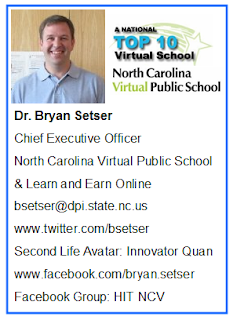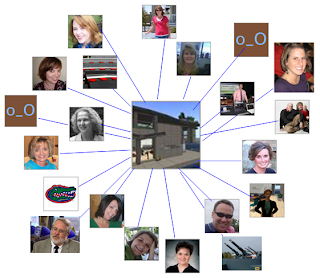[Below is today's blog posting from our executive director, Dr. Bryan Setser.]
21st Century Learners and Leaders:
Viral leadership? My thoughts are here on Sunday evening as I just finished watching United States Education Secretary Arnie Duncan speak over the internet in Cary, NC. The event was streamed live
here, and during the Q and A, I tweeted the event at my Twitter site here: http://twitter.com/bsetser .
Tomorrow these messages and resulting blog will also be featured on our virtual learning consulting page:
http://www.thevlc.org/ ; our NCPVS fan page on Facebook
here: and probably shared by others as first run information that educational leaders and learners will either use in their work or not.
But at some point folks, not using information to change the way the world learns and works is on the leader. Our kids are learning in a viral, on-demand world, and as Secretary Duncan announced tonight - $350 million more is on the way to help pay for 21st-Century Assessments. Will your district be ready? How will you know? How will you learn about new and different ways to assess learning? My suggestion is to stay ahead and on pace with the knowledge by considering a new “viral leadership” approach for your district.
In my blog this week, I take the recent 5 Habits of Successful Executives on Twitter in the
article by Bruce Philp at mashable.com and apply the examples to the type of viral leadership superintendents and principals can use in school districts. Consider some new and viral ways of leading and learning to impact the lives of your students in your schools and/or districts.
5 Habits of Successful School Leaders on Twitter1. You are the conscience of your school system or school.For many community members, an ideal superintendent and/or principal is someone who uses their power to make sure teachers and educators do what they are supposed to in order to help children be successful. As a school leader on Twitter, that should be your platform with a twist. What many people also sense in an effective school executive on Twitter is not the echo of what we "have to do," but the principles by which they lead the school or district and their passion for the job. Skip the marketing; connect your school community to your core beliefs about teaching and learning. Sample superintendent tweet: So proud of our focus on technology. More kids have access to learning over the net now than at any time in our history.
2. Don’t sell the district or school, share it.
Twitter isn’t advertising, it’s a conversation. Great school leader tweeters don’t try to sell to their followers, they try to engage them in a personal way. They share things about their school or district’s culture, their leadership values, the great people around them. They help followers with problems. They make student success personal, and sometimes even funny. Each tweet should be a window into the life of the school or district behind the marketing, which will make the community support stronger as a result.
Sample tweet: Finance officer Jim Timmons and I discussing the budget. Boy do I need some input from the Rotary Club leaders today :)
3. Be a real human being. Gates and Dagget first told you about this with relationships, now practice it in a viral way.On Twitter, what you talk about is who you are. Every Twitter user’s update history paints a true portrait of their character and what matters to them. So, the best school leader tweeters are real people and sound like real people — always. They know the responsibility to keep their brand honest is a duty they owe their customers, but they also know that baseball practice, Saturday errands, and that great burger they had at their favorite local eatery last night are the things that make them human. In moderation, share some of those things, too. People will be able to relate to you on a personal level and as a result, they will like and trust you more.
Sample tweet: My son thinks I’m old because I write him long text messages instead of in his code.
4. They write well.Nobody will say so out loud, but believe me: Bad grammar and punctuation, or hasty abbreviations to get the character count down to 140, are just a little too humanizing. Great leaders are characteristically great communicators, and it’s no different on Twitter. Sure, informality is fine, charming even, but confident prose is one way people recognize leadership in this forum. Nobody wants to do business with a sixteen-year-old CEO, and the best school leader tweeters don’t write like one.
Sample tweet: Back home from West High School choral concert. Loved the versatility of the ensembles and was moved by tonight’s soloist.
5. They commit.The best school-leader tweeters are people who have decided to join the party. They tweet a few times a day, and do so at least a few days a week. They build a community and become familiar with their followers. They establish relationships, running jokes, and a personality that defines them. School leaders on Twitter that don’t tweet often can seem distant, or worse, when they do. We don’t feel like they’ve joined the party. We just feel like they walked into the room to make an announcement and then left. I won’t go so far as to say that you shouldn’t be a Twitter user if you’re not prepared to commit. But almost.
Sample tweet: I’ve hired some great teachers this week. Tweet me tomorrow for some news on what makes them special.
In all, joining the education Twitter community as a leader makes your voice inseparable from your school or district’s reputation and its brand. What effective CEO and educational leader tweeters understand, though, is that this doesn’t mean you are that brand. People will follow you, initially at least, because they’re curious to understand who your company is in a deeper way than traditional media allow. But they’ll stay with you only if they like, respect, and trust what they discover. Which, as any leader will tell you, is what leadership is all about. To find executives and/or sample tweets on line go here:
http://www.exectweets.com/ or
http://www.wefollow.com/Have a great week with the virtual advantage of NCVPS and Learn and Earn Online!
Bryan
Dr. Bryan Setser
Executive Director
North Carolina Virtual Public School
Learn and Earn Online




















